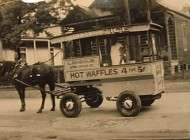By Andrew Dalton | SFist

Social media nerds will tell you the rise of the food truck was a result of laid-off cubicle jockeys with Twitter accounts and hot dog carts suddenly realizing they were pretty good at making fusion tacos. But that’s only half the story, apparently. We can also thank all those disappearing construction jobs for the sudden influx of mobile kitchens in cities.
The modern food truck has a founding narrative rooted in the Great Recession and the emergence of social media.
The popping of America’s housing bubble in 2007-2008 meant a stall in new construction projects, leaving food trucks without their best customers. Suddenly, hundreds of used food trucks were for sale. Simultaneously, the recession left many chefs unemployed and potential resteraunters nervous about the risk of opening a restaurant.
Entrepreneurial chefs bought food trucks and began selling their creations on the streets. Thanks to Facebook and Twitter, they could easily reach out to customers and publicize their daily schedules and offerings. A creative cooking culture developed to lure foodies to food trucks. It became a media sensation, captured in social media as well as television series like the Food Network’s Great Food Truck Race.
Unfortunately, for fans of standing up while eating, the Food Truck bubble could be the next thing to burst. The cost of a truck alone has hit highs of around $180,000, not to mention higher permitting costs. And of course, the rest of the restaurant industry is less than thrilled about them.
Anyhow, if you’ve ever wondered if it is actually possible to make any money from a food truck, or what’s even the point with so many permitting hurdles to leap over: you should read on.
Tags: economics economy food trucks



